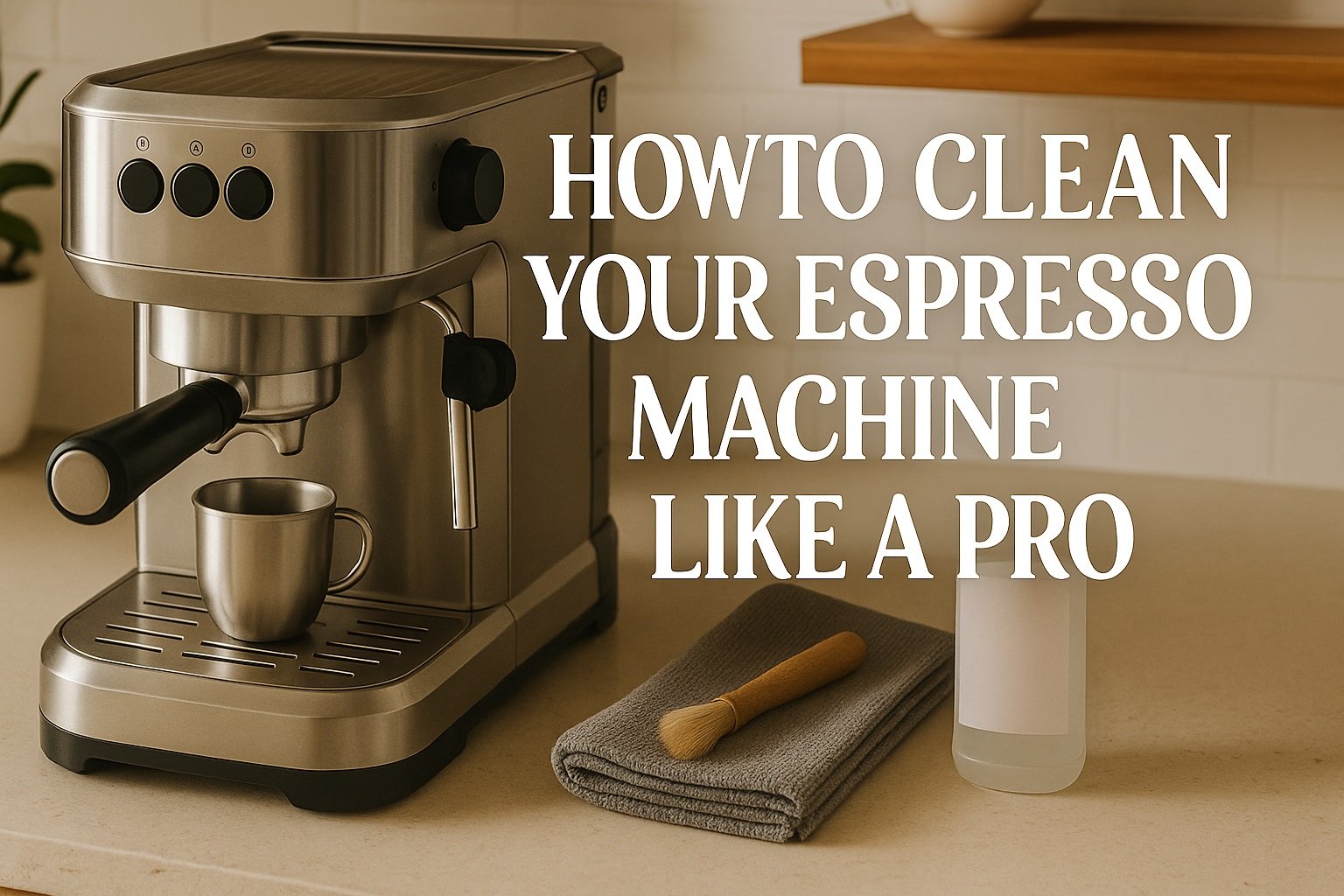We all love that perfect morning shot of espresso. But to keep our machine brewing like new, we need to maintain it regularly. As Serious Eats points out, keeping an espresso machine clean is wicked important – coffee oils can cling to metal surfaces and become musty, bitter over time. So if you’ve been wondering how to clean your espresso machine so each shot tastes great, you’re in the right place! A quick search for “how to clean espresso machine” shows lots of tips (and sometimes myths). We’ll cut through the clutter and share what really works for us. For us, espresso machine cleaning is part of the brewing ritual — like using fresh beans.
Maintaining and cleaning your espresso machine is all about practical steps and consistency. It’s like chatting over a cup of coffee). As part of our cleaning routine, we grab basic supplies and tackle tasks on a daily, weekly, and monthly schedule. The result? A gleaming machine and delicious espresso, every time.
Gather Your Cleaning Tools and Supplies
When figuring out how to clean an espresso machine, it helps to have the right supplies ready. Having these essentials on hand means the rest of the cleaning goes smoothly. For example, you might not realize it, but a descaling solution and a group-head brush are crucial. We always gather them before we start cleaning.
Before diving into routines, let’s make sure we have the right tools. You don’t need anything fancy, but keeping these supplies on hand makes espresso machine maintenance straightforward. Having them ready means no excuses for skipping a cleaning step.
- Group-head brush and portafilter brush: A stiff-bristled brush for scrubbing out grounds around the brew head and portafilter.
- Milk frothing jug and drip cloths: Clean cloths (microfiber or soft cotton) for wiping down the steam wand and exterior surfaces.
- Descaling solution: A neutral descaler or tablets (like Urnex Cafiza or similar) to remove mineral scale build-up.
- Water filter and replacement filters: If your machine has an internal water filter, keep it fresh; otherwise use filtered water to prevent limescale.
- Paper filters or blind (backflush) disc: Many machines come with a blind filter disc for cleaning the brew group; make sure you have it on hand.
Here’s a quick list of our go-to cleaning products:
Daily Espresso Machine Cleaning Routine
A little daily care goes a long way. Here are the steps we follow after each coffee session:
- Purge and wipe the steam wand immediately after steaming. We wrap a damp cloth around the wand and briefly turn on the steam to flush out milk residue. Then we wipe the wand clean. This 15-second trick prevents milk from drying and clogging the tip.
- Rinse the brew group and portafilter. Before and after pulling a shot, we run a quick water rinse through the group head (without the portafilter attached) to flush out used grounds. Then we knock out the puck of coffee from the portafilter and rinse it with warm water. Removing leftover grounds right away avoids stale buildup.
- Wipe the shower screen and gasket daily. We use a brush or cloth to scrub the grouphead gasket and metal screen where the portafilter locks in. This gets rid of any coffee stuck around the edges.
- Empty and clean the drip tray and water tank. Every day we toss old water and wipe out the tray. If our machine has a water reservoir, we top it up with fresh filtered water each day. (Using filtered water here also helps reduce scale.)
- General wipe-down. We give the exterior a once-over with a dry cloth each day – wiping off any coffee splashes or fingerprints. A neat machine just feels more professional!
All together, these quick daily steps prevent coffee buildup. As Seattle Coffee Gear notes, doing a quick water-only backflush every day or two helps clear out any residual grounds. We find doing these tasks after brewing means we never face a crusty, clogged machine.
Deep Cleaning: Weekly and Monthly Maintenance
On a weekly or monthly basis, we dive deeper to remove oils and scale. Our routine includes:
- Detergent backflush (1x/week or every few weeks). If your machine allows, we place a backflush detergent tablet or powder (like Urnex Cafiza) into a blind filter and run the brew cycle. This breaks down built-up coffee oils. Experts recommend doing a detergent backflush every 1–3 weeks for home use.
- Soak portafilter and baskets. We remove all metal baskets and soak them in warm water with a cleaning tablet for 15–30 minutes. Then we scrub them with a brush and rinse thoroughly. This deep-cleans oils that cling to the tiny holes.
- Clean the brew group shower screen (monthly). The metal shower screen behind the group head can clog with old grounds. Once a month, we unscrew this screen and soak it in a cleaning solution overnight. After soaking, we brush off any residue and rinse well.
- Inspect and clean the steam wand tip. While we purge it daily, about once a month we remove the wand tip (if it’s removable) and soak it in a milk cleaner solution. We also clear the holes with a paper clip or wand cleaning tool to ensure no dried milk is blocking them.
- Replace water filter and other parts as recommended by your machine’s manual. Using a fresh water filter (or filtered water) will minimize scale inside the machine.
- Descale the machine. We’ll cover this in the next section, but essentially we do a full descaling about every 3–6 months (more often if your water is very hard).
After doing these deeper cleans, our machine’s brew group and removable parts are almost like new. It’s worth noting that after using any cleaning products or detergent, we always run several cycles of plain water to rinse out any residue before brewing again. Also, some machines (especially commercial-style ones) may have special cleaning procedures in the manual — it’s smart to check your user guide so you don’t void any warranties.
Descaling Your Espresso Machine
Scale from hard water is one of the biggest enemies of espresso machines. Minerals can accumulate inside boilers and pipes, hurting both performance and taste. To descale our machine, we do this about every 3–6 months (more often if your water is very hard). Here’s how we do it:
- Prepare the descaling solution. We mix a 50/50 solution of water and a recommended espresso descaling product (or use a packaged descaling tablet as directed). Serious Eats warns against using straight vinegar, as it can leave strong odors and affect the flavor of your coffee, so we stick to a neutral descaler.
- Run the solution through the machine. With the brew head and steam wand turned on (without coffee grounds), we pump roughly half the solution through the brew head and steam wand. This fills the boiler and lines with the cleaner.
- Let it sit. We turn off the machine (or heating element) and let it sit for about 15–30 minutes. This dwell time lets the solution loosen scale inside the boiler and pipes.
- Flush out the cleaner. We turn the machine back on and run the rest of the solution through the system. Then we immediately refill the tank with clean water and flush multiple tanks of fresh water through both the brew head and steam wand to rinse out any remaining cleaner.
- Reassemble and test. Finally, we reassemble any removed parts and brew a few shots (discarding them) to ensure no cleaner taste remains.
Doing this regularly prevents scale buildup from disrupting your espresso extraction. In fact, Seattle Coffee Gear notes that performing this process every 3–6 months is key to long-term performance. If your machine’s manual has a specific descaling cycle (some high-end machines do), follow those instructions carefully.
Common Cleaning Mistakes to Avoid – Expresso machine cleaning tips
It’s just as important to avoid harmful habits when cleaning:
- Don’t use dish soap on brewing parts. Soaps can leave a residue that fights the coffee’s natural oils, altering flavor. Instead, use a dedicated espresso detergent or just hot water.
- Avoid abrasive scrubbing on stainless steel. For example, don’t scrub the steam wand with a steel pad. This can scratch the metal and even expose the inner copper. A soft cloth or the provided wand brush is plenty to clean off milk residue.
- Don’t neglect manufacturer guidelines. Always check your machine’s manual. Some machines have built-in cleaning cycles or parts that shouldn’t be backflushed. Following the manual ensures you don’t void warranties or damage sensitive parts.
- Don’t skip water filtration if needed. Using very hard water without a filter leads to fast limescale build-up. If your machine supports it, install a water filter or use bottled/filtered water.
- Avoid letting grounds and milk sit. As Faema Montréal notes, leaving old grounds in the portafilter or dried milk on the wand invites bacteriaf. A quick wipe and knock-out after each use prevents these problems.
By steering clear of these mistakes, we protect our machine and the taste of our espresso. Keeping your espresso machine clean pays off in every cup. With a simple daily routine, we avoid the extra work of major clogs and enjoy the peace of mind that comes from a well-maintained espresso machine!
For us, espresso machine cleaning isn’t a chore—it’s part of the ritual. Mastering how to clean your espresso machine properly is the final step toward brewing that perfect shot at home. Enjoy a clean expresso machine at home and an even better cup!
And if you are looking for the perfect expresso machine por you, check it at Best Coffee Machines for your pocket in 2025.









